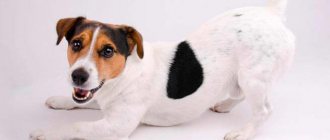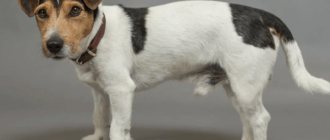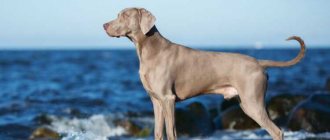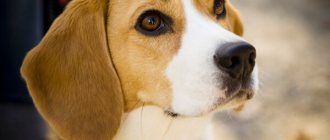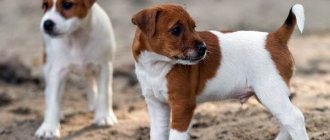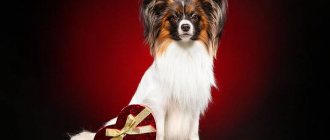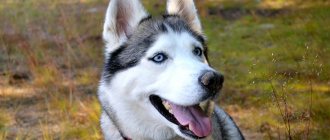Mudi are small dogs with pointed ears and a compact body covered in shiny, curly hair. During their existence, they have proven themselves well as shepherds, easily managing numerous herds, and now they perform guard duty and live in families as pets.
Let's find out what Mudi are and what the specifics of keeping the breed are.
Origin story
The Mudi dog (accent on the last syllable) is a dog of the Hungarian cattle breeders. These shepherds are one of the most ancient representatives of dog breeds. The breed was officially recognized only in the 19th century, but was formed two centuries earlier. The cattle were driven through the pastures by dogs, very similar to modern shepherd's assistants, who have proven themselves quite well as capable beaters of large flocks of sheep.
Hungarian farmers decided to breed a breed that would be an assistant in grazing livestock and could successfully serve as a hunter and guard of homesteads. These shepherd helpers were bred by crossing different breeds of shepherd dogs with the necessary characteristics: German, Croatian, and also Hungarian Pumi.
As a unique breed, attention was paid to the Mudi only in the early 30s of the 20th century. Its discovery belongs to Dr. Dezso Feniez, who was an expert in dog breeding. He recognized that this rare and specific breed represented a completely stable and homogeneous type and could be considered new. During the Second World War, the Mudi Sheepdogs were almost exterminated, but by the mid-60s the population of these dogs was restored. It was during that period that the genes of the Belgian and Scottish Shepherds were added to the genotype of this type of dog.
Find out the best top 10 dogs for apartments, dogs of medium and large sizes, the breeds of the kindest and most expensive dogs in the world, fighting dogs and the most terrible and dangerous dog breeds.
The modern Mudi herding dog is a universal dog with all the qualities required for this breed. He will make an excellent company for hunting, country walks and sports games, and will also be a devoted guard for the home and family.
Interesting Facts
- The Hungarian Shepherd is a dog for experienced people. A novice dog breeder should not acquire this beautiful, but difficult to train breed.
- One of the oldest nurseries specializing in breeding Komondors is located in Hungary. KARCAGPUSZTAI - that's what it's called. The founder and first owner of the kennel gave the world many healthy, strong and balanced representatives of the breed. Unfortunately, he passed away in 1995, and now his daughter runs the nursery.
var blockSettings13 = {blockId:"RA-116722-13",renderTo:"yandex_rtb_R-A-116722-13",horizontalAlign:!1,async:!0};
if(document.cookie.indexOf(“abmatch=”) >= 0){ blockSettings13 = {blockId:”RA-116722-13″,renderTo:”yandex_rtb_R-A-116722-13″,horizontalAlign:!1,statId: 7,async:!0}; }
!function(a,b,c,d,e){a=a||[],a.push(function(){Ya.Context.AdvManager.render(blockSettings13)}),e=b.getElementsByTagName(" script"),d=b.createElement("script"),d.type="text/javascript",d.src="https://an.yandex.ru/system/context.js",d.async =!0,e.parentNode.insertBefore(d,e)}(this,this.document,"yandexContextAsyncCallbacks");
- Komondor fur grows throughout its life. By the age of the dog, the weight of the hair is about 7 kg, and the number of cords is 2000 pieces.
- Due to its unique hair and excellent guard qualities, the Komondor is listed in the Guinness Book of Records.
- The lifespan of this dog is 12-13 years.
- The Komondor is a king among shepherds. This characteristic is given to the breed by the famous Czech teacher Jan Amos Komensky.
- The Hungarian dog also appeared in the famous cartoon “Little Fox Vuk”. The “cartoon” dog has no harnesses, but even cunning foxes speak interestingly about his devotion.
- And another representative of the breed can be seen in a cartoon version. “Horns and Hooves,” released in 2006, is a cartoon about how animals live on a farm. And there is shown an absolutely charming white dog, whose fur is intertwined in many cords. The white dog is not only beautiful, she also knows how to play the double bass, especially for cow discos.
- Hungarian Shepherd puppies are born with completely white, short hair. Tourniquets appear at the age of 1.5-2 years.
Appearance
Due to the fact that during the Second World War the breed was on the verge of extinction, it had to be restored literally from scratch, modifying the standard to bring it as close as possible to the original image.
Color
There are several recognized colors: brown, black, white, ash, merle, and their variations: for example, brown and ash merle. Sometimes there are puppies with tan, “wolf” or brindle coloring. Pale yellow merle may appear. But first of all, all the colors of the Hungarian Shepherd Mudi are even. Interestingly, the solid color is obtained thanks to the dominant K gene. This gene does not allow the appearance of brindle or black-red-white, which is present in the husky.
Standards
- General appearance : proportional body structure, small size. Males - 43-45 cm, females - 40-42 cm.
- Weight - 8-13 kilograms.
- The coat is wavy on the body, smooth on the head and front legs.
- The head is wedge-shaped, the forehead is sloping, the back of the head is flattened.
- The skull is dome-shaped.
- The muzzle is elongated, less than the entire length of the skull.
- The nose is narrow, rounded towards the nose. The color is black in both white and black dogs. The rest have brown lobes or the color of their fur.
- Lips are tightly adjacent, the line of the mouth drops slightly when moving to the neck.
- The teeth are small and have a scissor bite.
- The eyes are almond-shaped, set at a slight slant. There must be only dark eyes, blue are acceptable in the merle color.
- The ears are erect, like those of German Shepherds, with thick hair.
- The body is compact, the back is always straight, muscular, and slopes down to the croup. The height of the withers is approximately equal to the length of the body.
- Neck - located at an angle of about 50 degrees to the spine, muscular, strong, no collar. Males have a mane.
- The chest has a slight curve in front, the ribs are flattened.
- Tail - set high, long, hanging, with thick hair. When the dog moves or is happy, the tail takes on a crescent shape. Docked tails are acceptable.
- Paws are medium-sized, with pronounced muscles, black claws, round paw pads.
Description of the breed with photos
The Hungarian Shepherd dog breed standard, according to the FCI, looks like this:
- General appearance: large, harmoniously built dog with a mistrustful character.
- The head is wide and large, with a convex skull and well-developed brow ridges.
- The muzzle is medium, the transition from the forehead to it is very pronounced.
- The eyes are almond-shaped, deep-set, and always dark brown in color. Light shades are undesirable; blue-eyed dogs are considered a breed defect.
- The nose is large, with wide nostrils. The nose is always black; other shades are considered undesirable.
- The jaws are strong and well developed, the lips fit tightly to the teeth, and are black in color.
- The ears are medium set, hanging from the base in the form of an elongated letter “U”.
- The neck is of medium length.
- The body is elongated.
- The back is wide, short and level.
- The loin is muscular and wide.
- The chest is deep, with highly developed transverse muscles.
- The limbs are straight and muscular.
- The tail is set low, reaches the hock joint, and is slightly curved at the end.
Size and weight
The Hungarian Shepherd Dog or Komondor has gigantic dimensions.
| Gender of the dog | Height (cm) | Weight, kg) |
| Male | 70-85 | 50-60 |
| Bitch | 65-72 | 40-50 |
Color and coat type
The only acceptable color is white.
The coat is hard and consists of numerous cords. Their greatest length on the croup and hips is from 20 to 27 cm. The shortest hair is on the lips and paws, it is 9-11 cm.
Flaws
The only drawback of the Hungarian shepherd dog is that representatives of this breed are very playful and active. If you are looking for a dog that would spend hours basking next to you on the sofa, then this is not about Mudi.
The following dog breeds are suitable for keeping in the house: Chihuahua, Basset Hound, Biewer York, Miniature Poodle, Welsh Corgi, German Spitz, Maltese, Maltipoo, Pomeranian.
Aggressiveness
For some breeders this will be an important advantage, and for others a serious disadvantage, but the Hungarian Vizsla is practically devoid of aggressiveness. She was used to retreating, not attacking. Of course, this does not apply to hunting - here the dog transforms and pursues wounded prey aggressively, as befits a good hunter.
But there is no aggression towards dogs and especially people. Some will find this a serious plus - the likelihood of fights and other conflicts with dogs and animals is minimal. But at the same time, it is worth understanding that because of this, the Vizsla, despite its strength, speed and endurance, will not be able to be not only a good guard, but also a watchman. The breed has a certain guarding instinct, but if a stranger invades your apartment or house, the most you can count on is a loud bark. The dog will never attack an intruder. The only exception is if he attacks the owner. But even in this case, you should not expect that the pet will be useful - after all, it is not accustomed to attacking people
At best, it will distract attention and allow the owner to buy enough time to get away from danger.
Disqualifying faults
The nose of black, yellow, ash, white dogs is flesh-colored, spotted or brown. Teeth (one or more) may be missing.
Find out also how to train your dog to go to the toilet outside
The upper jaw protrudes beyond the lower jaw and vice versa. Light brown eye color in black dogs. Ears that droop rather than point. The hair is short and straight all over the body, and long on the head. Total white, zonal coat color, black and tan with splashes of yellow and brown. Not tall enough or too tall.
Description of the Hungarian Shepherd Dog
The standard positions the Komondor as a herding dog. However, now Hungarian Shepherds are more in demand in the police and security services, and are also used to help children with developmental disabilities and seriously ill people (canistherapy). Often these dogs are kept as bodyguards, just pets and excellent companions.
Breed standard
The Komondor is a tall and powerful, but not heavy dog with a voluminous, well-developed muscular corset and strong bones. The body is slightly elongated, shaped like an inclined rectangle, with a very muscular, wide and short back, clearly defined, elongated withers, widened, deep sternum, slightly sloping, not very long, wide croup and a slightly tucked belly line.
The Komondor is a large dog, appearing even larger due to the abundance of hair.
- A wide head, harmonious and proportional to the overall physique, with a dome-shaped skull and a blunt muzzle, the length of which is slightly less than the length of the skull, is set on a short, dry and muscular neck (without a collar and without a dewlap).
- The nose is straight, bluntly cut, pigmented black. The stop is pronounced, but not steep.
- The jaws are powerful and strong in a regular scissor bite with full dentition. The lips are tight-fitting and black.
- The eyes are set straight, dry thin eyelids fit well. The iris is dark brown. The look is meaningful, calm.
- The ears are hanging, located quite high.
- The low-set, hanging tail rises to the level of the back when excited or in motion.
- The legs are powerful, long, column-shaped, with large joints set vertically and parallel. Strong, large, rounded paws with well-jointed toes, elastic, thick and resilient slate-gray pads, hard claws (also gray).
- Height at withers:
- in females - from 65 cm;
- for males - from 70 cm.
Character and behavior
Although this fearless, hardy and strong dog has an inexhaustible supply of energy, it is obedient and easy to train. These are very brave and courageous dogs. They will never simply remain silent if something threatens them or their owners. When danger threatens, the size and frightening appearance of the enemy is not at all frightening to the Mudi.
Did you know? Sometimes the Mudi herding dog, as a working dog, cooperates with the Hungarian police and customs service thanks to its keen sense of smell. These shepherd dogs successfully find hidden drugs in luggage. Mudi are also known as brave rescuers in mountainous areas, such as in Finland.
For this reason, a Hungarian pet needs an eye and an eye, and it is also necessary to constantly pay attention, otherwise a representative of this breed left without proper education will turn into a “natural disaster” for its owners. Moodys are very psychologically sensitive and have an independent character. Ideal for grazing large herds. Representatives of this breed have a keen sense of smell, which is why owners take Mudi to hunt wild boar.
Literature
- Pal Sarkany, Imre Ocsag "DOGS of Hungari", Corvina Press.
- Magazine "Kutya" No. 09/1999.
- Joy Levy "Komondor".
- Friend magazine for dog lovers, No. 7 July 2003.
- Friend magazine for dog lovers, No. 6 June 2004.
- “Friend” magazine for dog lovers, No. 9 September 2005.
- Magazine "Komondor News MASKC" No. 2 for 2006.
- Magazine "World of Dogs" June 2006.
- Juliet May "All about the most popular dog breeds."
- Naimanova - Gumpal “Atlas of Dog Breeds”.
The Mudi is a herding dog that originated in Hungary in the 17th century. These dogs are excellent shepherds and watchdogs, as well as rescuers. Mudi, as a dog breed, has many positive qualities.
Moody and man
The most important thing in the life of a curly-haired Hungarian Shepherd is its owner, because Mudi are monogamous. Therefore, these dogs do not show aggression towards humans, but on the contrary, they adore their owners and are ready to serve and protect them until death. In a friendly home environment they are very playful and affectionate. Such dogs fit perfectly into large families and become full members of them. These dogs can be a little aggressive with strangers.
Important! Mudi owners should pay attention to the fact that these dogs have a tendency to bite, so it is not advisable to leave them alone with small children.
The Hungarian Shepherd has highly developed hunting instincts, so they can pose a danger to small animals in the house.
Mudi are excellent exterminators of rats and mice, which are often a big problem for residents of private country houses.
How to choose a puppy
The rarity of Komondors means that puppies are almost impossible to purchase from a private individual. That is, you will have to contact official nurseries. The dog can be adopted as early as 45 days, but it is worth considering that it will not be vaccinated.
The breeder must provide documents for the animal: passport and pedigree. In addition, he is obliged to tell everything about the puppies’ parents, their diseases and shortcomings, and show at least one of them.
Little Shepherds are active, curious and playful. External criteria must meet the standards: the coat is light and soft, the bite is correct, the nose is painted, the tail is short. The cost of a dog depends on its appearance.
- The most expensive will be the descendants of champions who are assigned show class ( from 70,000 rubles ).
- Pet class and breed class can be purchased for 35-50 thousand rubles .
The Hungarian Shepherd is certainly a wonderful guard, it is serious and brave, and can protect against any enemy. But this breed is suitable only for an experienced breeder who has enough time and financial resources to maintain it. It’s impossible to make an apartment toy out of this dog.
Maintenance and care
These Hungarian Shepherds are unpretentious in grooming: after walks, just wipe the dog’s paws, tail and belly with a damp towel. It is not necessary to bathe a Mudi dog often, as these dogs are very clean. To do this, you need to use special tools. If the dog lives in a small apartment, then his energy can cause damage to the owners and pretty much fray their nerves. This freedom-loving shepherd cannot be chained. By constantly combing their pet's fur, trimming their claws on time, and ensuring the health of their ears and eyes, caring owners will receive a pleasant bonus from their pet's well-groomed appearance and its cheerful and playful disposition.
The Furminator is not an ordinary slicker brush for dogs; with the help of this tool you can rid your pet of most of the shed fur in a few steps.
Grooming
The Mudi coat requires virtually no maintenance. It does not tangle and does not require frequent washing or combing. It is advisable to brush it with a metal brush a little every day, but at least once a week.
Find out what criteria you use to choose a dog clipper at home.
Physical exercise
Mudi Sheepdogs are suitable for keeping in a country house. They can also be kept in a spacious city apartment, but subject to daily walks and physical exercise and stress. Only by frolicking on the street will the four-legged naughty boy expend all his energy, and then temporarily calm down. Physical activity helps representatives of this active breed get tired faster and at the same time maintain their health. You can include training in various tricks here.
Find out which toys are best for your pet.
Nutrition
Like all shepherd dogs, the Hungarian Cattle Dog needs a properly balanced diet: all the necessary fats, proteins and carbohydrates. It is necessary to include animal products in the Mudi diet: meat and its by-products, dairy products, add cereals, vegetables, and fruits to the diet.
Choose the most suitable food for your dog: Pedigree, Grandorf, FortiFlora.
Dog experts also recommend giving your dog boiled eggs, boneless fish and cheese. There are also food taboos for Hungarian pets - sweet, smoked, spicy foods, as well as baked goods.
Important! We must not forget about a bowl of fresh water, which should always be in the pet’s field of view.
All this can cause allergies and stomach diseases. Balanced dry food containing the necessary set of microelements for a dog is also acceptable.
Description of the Dutch Cattle Dog
The main purpose of Dutch Shepherds is herding work; in some regions of the Netherlands they still do their direct duties. However, more often they act as service rescue dogs, athletes, guide dogs, as well as simply pets and companions.
Breed standard
The Dutch Shepherd is a fairly tall, light and agile dog of a dry build, visually similar to a wolf, with well-developed voluminous muscles and large, strong bones. A well-balanced body of a slightly elongated format (the ratio of the length of the body to the height at the withers is 10:9) with a straight, short back, a strong, not too long loin, a deep, rounded chest, smoothly turning into the bottom line.
The Dutch Shepherd is a fairly large dog.
Breed standard:
- A dry, elongated head, proportional to the overall build, with tightly stretched skin (without folds or wrinkles) is set on an elegant (without dewlap) neck that smoothly merges into the body. The flat skull is somewhat shorter than fashion. The stop is barely noticeable, smooth.
- Powerful jaws with full dentition in a regular scissor bite. Tightly compressed lips fit well.
- The nose is only black.
- The slanted almond-shaped eyes are medium in size. Iris of dark shades. The look is smart and lively.
- Pointed, small, triangular ears are set high.
- The slightly curved tail hangs down in a calm state; when excited or in motion, it rises up strictly vertically (does not hang to the sides).
- Lean, well-muscled, powerful limbs are absolutely straight and parallel. Paws with long toes curled into a ball, elastic dark pads and black claws.
- Height at the withers: in bitches - 55–60 cm;
- for males - 57–62 cm.
Best articles: How many trees are there on Earth?
Features of the coat
Depending on the type of coat, representatives of this breed are divided into three varieties:
- Long-haired (the rarest, almost extinct). The coat is straight (without waves or curls), lying tightly, elongated, rather coarse and hard to the touch. The undercoat is thick and dense. The hair on the head, ears, hind legs and paws is noticeably shorter. The tail is covered with thick hair, and there are feathers on the ears.
- Wirehaired. The guard hair is rough, hard and tousled, the underhair is dense and soft. The muzzle has a pronounced beard and protruding eyebrows made of coarse fur. On the cheekbones, skull and ears, the coat is less developed. Pants (culottes) are clearly visible on the hind legs.
- Shorthair (most common). The coat is hard, somewhat short (but not too short) with a thick undercoat. The collar on the neck, the thick plumage on the tail and the feathering on the legs are noticeably pronounced.
The standard allows gray color with silver markings and black with golden spots of varying degrees of severity and brightness. Colored areas are located evenly over the entire surface of the body (including tail, collar, feathers, etc.). A black mask on the face is desirable. In wire-haired individuals, the spots are less noticeable, and additional colors are also acceptable: pepper and salt and gray-bluish with spots (silver or gold).
Gray and silver color is allowed by the Dutch Shepherd standard
Flaws
The following are recognized as defects:
- not black nose;
- ears are rounded, drooping or cropped;
- problems with the jaws (overbite, misalignment, underbite);
- incorrect coloring (inclusions of non-standard colors, too much black in the top layer, very large white spots on the chest and paws, white stripes and markings on other parts of the body).
Training and education
Due to their independent nature, training Hungarian Shepherds requires a long and persistent effort. The most important thing here is to be patient. But under no circumstances should you show aggression or irritation towards your pet. From the age of three months, puppies of this herding breed must be trained, accustoming them to their assigned place in the house, and also develop the habit of asking them to relieve their natural needs outside.
Important! It is best to train the Mudi during playtime so that she does not lose interest in the learning process.
Like any other breed of dog, the Moody Sheepdog must understand and strictly follow the specific commands of the owner. You can start training your pet with a simple walk together. You need to let the puppy run around, look around, explore its territory, let it satisfy its guard instinct and mark the boundaries. When walking, you also need to know when to stop: the pet should not be overtired, because if the dog is tired, then it may not want to learn the commands of its owner.
You should definitely know which commands are best to start training with and how to turn the training process into an interesting game.
One of the advantages of the Hungarian herding dog breed is that they are able to do the same thing for a long time, despite the heat or frost. Therefore, they feel quite comfortable during the long process of training. Another plus is that this dog is very obedient and not aggressive. These dogs love to please their owner, and he will be happy with any encouragement. All these qualities will manifest themselves in the dog’s behavior in the future.
Today, Mudi dogs do not necessarily need to be trained to guard herds. They love to participate in sports games such as agility and flyball.
Did you know? The French corsair Robert Surcouf earned the nickname "Dog Baron" due to the fact that he used moody dogs during the capture of ships. The pirates threw planks onto the conquered ship, along which a horde of angry dogs burst onto its deck with loud barks. Subsequently, on the pirate’s grave next to the inscription “All in the name of France!” the impression of a Mudi's paw was applied.
Description of the Croatian Shepherd breed, characteristics
The characteristic appearance of Croatian Shepherds makes them recognizable among other breeds of the first group. They are “dressed” with short wavy hair, but at the same time they have a smooth muzzle. The coat is very easy to care for, its length prevents tangles from forming, and its curliness adds charm to the dog without complicating its care.
Character of Croatian Shepherds
The Croatian Shepherd is passionate, hardy, unpretentious in everyday life, and easily adapts to changes. She has a lively personality and is very sociable.
Easy to train if you show a little patience during training. These dogs have high intelligence, thanks to which they can easily cope with large flocks of sheep. Moreover, the actions of Croatian Shepherds in this case are based not so much on the skills acquired during training and training, but on the ability of these dogs to make the right decisions on their own. Many shepherds claim that the intelligence of Croatian Shepherds is so developed that they can even remember the names of sheep. Nowadays, the Croatian Shepherd is used as a companion, as well as a guard and herd dog.
Breed standard Croatian Shepherd
- Croatian Shepherd Dog
- FCI Standard No. 277
- Origin: Croatia
- FCI Classification: Group 1: Sheepdogs and Cattle Dogs, excluding Swiss Cattle Dogs.
- Section 1: Shepherd dogs.
- No operational tests.
Health and illness
Any hereditary or specific diseases for mudi are unknown. The main thing is to get all vaccinations on time and monitor your pet’s health. Sometimes dysplasia occurs. Dogs whose owners pay enough attention to the physical activity of their pet do not have problems with the musculoskeletal system. Proper nutrition and the possibility of a permanent active lifestyle for the Mudi Shepherd will guarantee its beauty and health.
To protect your pet, familiarize yourself with the symptoms and treatment of dog diseases such as dirofilariasis, piroplasmosis, mycoplasmosis, toxoplasmosis, enteritis, distemper, coronavirus, staphylococcus, pyometra, pancreatitis, eclampsia, epilepsy, chlamydia.
The average life expectancy of a Moody is 14 years.
Nutrition
Mudi is a dog that is unpretentious when choosing food; it can eat from the owner’s table, but this should not be abused. The food a person takes may be poorly digested and cause heaviness in the pet’s stomach.
For a dog, it will be enough to eat 2 times a day, without overeating. If your dog hasn't emptied the bowl within 20 minutes, you can throw away the leftovers and add a smaller portion size to the next meal.
Mudi does not need to be fed fatty foods; try to maintain a balance of nutritional components in natural food. When using dry food, you need to ensure that it contains fewer chemicals.
Breeding
The most successful days for mating are considered to be from the 11th to the 15th day from the start of the female’s estrus. It is ideal to breed a female and male Mudi breed that is about 2 years old. If this is done at an earlier age, it will negatively affect the health of both parents and offspring.
To successfully breed animals, you don’t need to feed them, but it’s better to give them a good walk and give them the opportunity to get to know each other well. It is best to do this on neutral territory so that they can frolic and run around. It is advisable to breed only in the male dog's territory.
We recommend that you read about the characteristics of estrus in dogs and the characteristics of mating dogs.
After ejaculation, a spasm of the pelvic muscles occurs in the female. It happens that after this process the spasm does not occur, and the male may lose interest and desire to mate again. Then you need to repeat the mating in a day or two.
Estrus in Croatian Shepherds
- age of onset of the first estrus in a female is 6-12-14 months;
- duration of estrus is 20-22 days, sometimes up to a month;
- frequency of estrus – 1-2 times a year with an interval of 6-9 months;
- signs of estrus – swelling of the dog’s external genitalia, spotting;
- frequent urination - having to walk more often than usual;
- psychological signs - a change in the dog’s behavior - from aggressive to lethargic;
- perhaps there is a change in appetite and the dog drinks more water;
- often bitches begin to shed before going into heat;
- lick the loop intensively.
You can notice the approach of estrus while walking your dog. Behavior can change, often the dog becomes active, playful and disobedient, or, on the contrary, looks unhappy and lethargic. The bitch makes frequent marks - scent “lures” for male dogs, and urination occurs more frequently. The loop becomes more and more swollen; when pressed, you can see a discharge of light pink or dull pink color. If you notice changes in the dog's behavior, do not be lazy and check the dog every day for the onset of heat by dabbing the bitch's loop with a napkin or toilet paper. Pinkish discharge will be the beginning of estrus - mark this day in your dog’s notebook.
The course of the dog's first heat.
- The first heat in dogs is not the same as the next one.
- It may be shorter or longer than the usual estrus period.
- The bitch has either only weak manifestations of estrus, or, conversely, very heavy discharge.
- The first heat may suddenly stop, and then after some time begin again.
- There may be mucous discharge from the loop, a smell that attracts males, and the estrus itself will begin after some time.
- Try not to miss the start time of the first, and subsequently the second estrus, in order to correctly determine the intervals between estrus and know their timing and duration.
Precautions during estrus. If you are not interested in getting puppies from a dog, you need to take precautions during heat:
If you are not interested in getting puppies from a dog, you need to take precautions during heat:
- walk your dog ONLY on a leash: even the most obedient dog these days can simply run away, not paying attention to commands;
- do not allow male dogs to mount the dog: if sexual intercourse begins, it is almost impossible to separate them;
- during a walk, literally DO NOT take your eyes off the dog, even when buying bread in a tent, eliminate or minimize contact with male dogs;
- there is a danger of the dog catching a cold in the cold season, the best way to protect yourself is not to walk for a very long time in cold weather and use dog clothes;
- If your dog lives freely on your territory, then from the moment the estrus begins, lock the dog in an enclosure.
Reviews
- Maria:
“I have been looking for a puppy of this breed for two years. We managed to purchase a dog from a Hungarian kennel after six months of negotiations. The breed is amazing, their health is simply excellent, they are hardy and nimble. Undeservedly rare! At Russian exhibitions I see them “once every five years”; in Europe there are several well-known nurseries, and things are better there. On the street they periodically call him a mongrel, which is strange to people.”
- Anastasia:
“I have a male Mudi. Before that, I kept a border collie, they are really similar in behavior, but they seem to be more reasonable and tougher. Every 2 weeks we go to herd sheep, the trainer is delighted with him, he says he has rarely seen such work. We'll start practicing PSS soon, we'll see how it shows itself there. By the way, ours is not a gibberish, he squeals when he drives a flock"
Share link:
Standards
A new breed standard was written by Dr. Zoltan Balassi in 1966 to apply for FCI recognition. This standard was based on only a few examples, the main differences from the original standard being size and color.
The FCI Hungarian Shepherd was recognized in 1966, but very few breeders were involved in the breeding then, as is still the case today. The standard was first rewritten in 2000, and the current FCI breed standard dates back to 2004. As was the case 80 years ago, there are many different types within the breed.
Tail docking is officially prohibited throughout the world.

